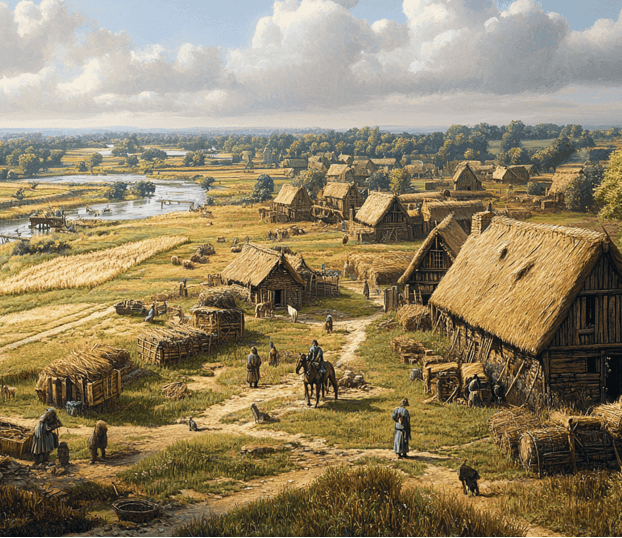
The Tribal Hidage is a compelling relic of dark age England: a mysterious, fragmentary window into the world of Anglo-Saxon tribes, kingdoms, and their economies. Compiled sometime between the 7th and 9th centuries, this enigmatic list documents thirty-four tribes, assigning each a number of “hides” – a land unit linked with taxation, society, and power. Far more than a simple census or tax roll, the Tribal Hidage offers tantalizing clues about politics, administration, economy, and the very fabric of early English society.
The World of Early Anglo-Saxon England
To understand the Tribal Hidage, one must first step into the world from which it emerged: a patchwork of independent realms and scattered tribal territories, nestled amidst forests, rivers, and marshes. This was a formative period when tribal identities and political boundaries were still fluid, shifting under the weight of kings, conquerors, and new social structures.
Mercia, Wessex, Kent, and other major kingdoms – names redolent of later legend – jostled against minor tribes and chieftains whose own histories remain shadowy. Amid this complexity, the Tribal Hidage emerges as both an artifact of dominance and a reflection of how these relationships were managed and recorded.

What Is a “Hide”?
Central to the Tribal Hidage is the concept of the hide. In Anglo-Saxon times, a hide was more than just a patch of earth; it was a unit of land deemed sufficient to support a large household or warrior’s retinue. Later, a hide often represented around 120 acres, though the actual size likely varied depending on region, productivity, and changing practices over centuries.
The hide wasn’t just a measure for farming: it was woven into the laws, taxation, and the calculations of tribute and military duty. Powerful lords and kings counted hides to calculate obligations, raise armies, and amass the resources that would help them hold or expand power.
The Construction and Purpose of the Tribal Hidage
The Tribal Hidage itself is a list, often termed an “assessment” or “tribute list”, that assigns each tribe, chiefdom, or kingdom a certain number of hides. These numbers often seem artificially rounded, such as 7,000 hides for the East Saxons and South Saxons or a whopping 100,000 hides for Wessex. This has led generations of historians to debate its origins, purpose, and reliability.

Possible Origins
While the origins of the list are fiercely contested, the consensus places its compilation somewhere between the latter 7th and 8th centuries, though some scholars argue for dates as early as the 620s or as late as the 780s. The list’s very structure suggests it was created in Mercia or possibly Northumbria, reflecting the regional dominance of those powerful kingdoms at various points.
Many believe the Tribal Hidage was drawn up for a Mercian king such as Offa or an earlier ruler, to help assess and levy tribute from subject peoples. The idea was simple: control the land, count its productive units (hides), and demand tribute, service, or loyalty in return.
Tribute, Tax, and Administration
The numbers of hides weren’t simply abstract figures. In a world where central administration was limited or embryonic, measuring hides allowed rulers to impose taxes, conscript soldiers, or demand food-rents, much as later Norse or Norman kings would do. It was a way to transform economic might into military and political power, and a record of which tribes were expected to pay what, and when.
The roundedness and sometimes exaggerated nature of some figures suggests these weren’t detailed surveys but were symbolic, reflecting the status and importance of each territory at a given moment. For example, Wessex’s huge assessment may reflect its prestige or political relevance rather than an actual survey.
Mysteries and Uncertainties
Despite its apparent administrative function, the Tribal Hidage is riddled with puzzles. Many tribes listed have left only the faintest traces elsewhere in the historical record. Some names resist identification, their lands now lost or absorbed into later counties and kingdoms. In certain cases, the list is our only witness to their very existence.
Attempts to map these tribes onto modern geography are speculative. The meanings of some tribal names, their locations, and their actual influence are subjects of ongoing debate. The Tribal Hidage, then, becomes a ghost-map of a vanished England, offering fleeting glimpses into an era of local lords, shifting frontiers, and uncertain allegiances.
The Thirty-Five Tribes and Their World
At the heart of the Tribal Hidage are its thirty-four tribes. The list begins with Mercia, assigned 30,000 hides, followed by groupings of smaller people, some with fewer than 1,000 hides. The largest single allocation goes to Wessex (100,000 hides), underscoring its later dominance and perhaps its mythic status in retrospective eyes.
Other major kingdoms – East Anglia, South Saxons, East Saxons, Kent – fill out the roster, alongside minor tribes and principalities that have left few footprints in later history. In all, the list captures a political geography that was in the midst of transformation, as larger kingdoms absorbed smaller ones and the patchwork of old tribal polities gave way to more centralized rule.
Sample Tribes (with assessed hides):
- Mercia: 30,000 hides
- Wessex: 100,000 hides
- East Angles: 30,000 hides
- Kent: 15,000 hides
- East Saxons: 7,000 hides
- South Saxons: 7,000 hides
Smaller and sometimes mysterious territories listed include the Herefinna, Hendrica, Noxgaga, and Unecungaga, among others.
Administration, Law, and Social Structure
The Tribal Hidage wasn’t just a tool for kings – it reflected deeper currents in Anglo-Saxon society. The importance of land units like the hide is evident in law codes (such as Ine’s Law, c. 700), where fines, wergild (man-price), and rights could be based on how much land a person held.
Hides determined not only taxation levels but also military obligations: a certain number of hides had to supply a warrior to the king’s army, or a ship for defense. The system held echoes of continental practices but was distinctly sculpted by English realities: village meetings, communal rights, and the changing balances between local lordship and central authority.

The Legacy of the Tribal Hidage
Despite its obscurities, the Tribal Hidage’s legacy looms large for historians. It has informed countless theories about English state formation, tribal structures, and early medieval politics. It tells us that by the 7th to 9th centuries, kings were actively tallying, taxing, and organizing their realms – marking a shift from the era of loosely-connected tribal chieftains to one of larger, more centralized states.
It is also vital for identifying lost peoples and shadowy regions whose memory lingers only in these lists. The document survived in three main manuscript traditions, with variants in spelling and coverage, each pointing to long use and adaptation. To this day, historians approach the Tribal Hidage with caution, using it to map shifting frontiers, understand economic life, and trace the emergence of kingdoms that would shape England’s future.
What’s clear is that the Tribal Hidage stands as a rare, precious snapshot: a record of a time before England was unified under one monarchy, a time when local lords still mattered, and when the boundaries of power, land, and tributary obligations were in constant flux.




